Why Does My Egg Look Weird? (And Is it Safe to Eat?)
Posted on: November 21st 2022

Hens are more than just egg-laying machines. While chickens can provide us with delicious, healthy eggs year-round, no chicken will always lay perfect eggs. Every once in a while, farmers will find that a few eggs look weird among their standard egg haul. While finding a bizarre egg might seem problematic, it’s usually nothing to be concerned about. Birds, like all creatures, have bodies that produce odd results sometimes. Eggs are no different — they can come in dozens of colors, textures, sizes, and shapes.
Odd eggs can have several causes, including disease and stress. Sometimes, however, they just happen, and no one knows why. You can safely eat certain deformed eggs as long as the shells are intact. If you ever feel uncomfortable eating an egg or aren’t sure it’s safe to eat, toss it. It’s always better to be safe than sorry when it comes to food.
Let’s explore all of the irregularities that can happen to your eggs and what the potential causes may be. We’ll go over the causes of deformed eggs, the different types, and whether an odd egg is safe to consume.
What Causes Irregular Eggs?
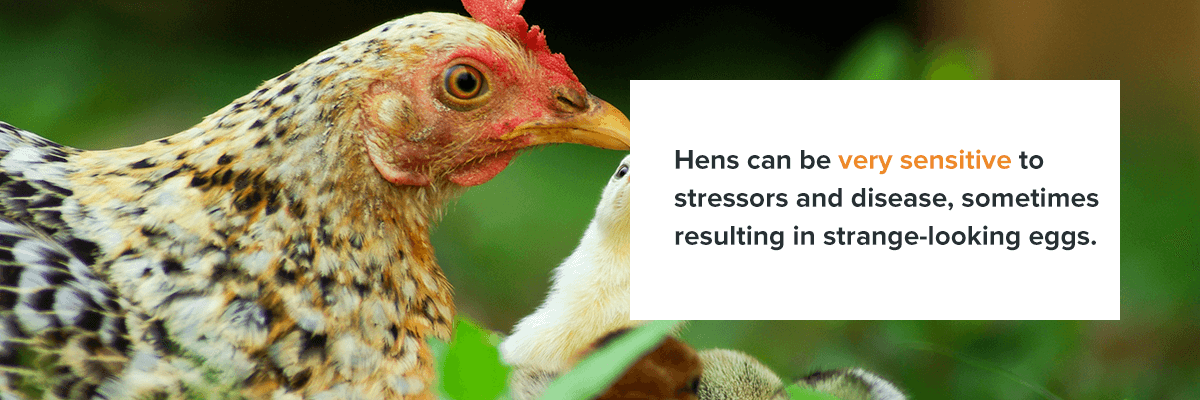
Irregular eggs can have several causes. Hens can be very sensitive to stressors and disease, sometimes resulting in strange-looking eggs. Keeping chickens happy, healthy, and stress-free is essential to producing good eggs. While farmers can’t prevent deformed eggs with complete certainty, they can watch out for their causes and address them if anything seems off.
Stress
Birds can become stressed by other animals, overcrowding, changing lights, weather, and other factors. Chickens might become stressed due to frequent handling and transport, or they could be afraid of predators. There are lots of social, psychological, and physical factors that can lead to stress in a flock. Stress can cause hens to lay unusual or deformed eggs, unnecessarily putting strain on their bodies.
Farmers can reduce stress in the flock by protecting chickens from predators and excess handling. Farmers can also ensure their birds are comfortable and secure in their environment. It helps to keep chicken house lights on a regular schedule and level and watch out for overcrowding or improper rooster-to-hen ratios. Providing hens with enrichment keeps them entertained and active, which can also help reduce stress. Happy chickens produce happy eggs.
Disease
Parasites, infections, and other illnesses can all lead to egg problems. While lash eggs are the most severe result of disease, issues like infectious bronchitis can also lead to strange-looking eggs. Different conditions can put a strain on the bird and cause problems, affecting egg formation and leading to different textures or shapes among the eggs of sick birds. One weird egg isn’t usually a sign of an issue, but if farmers begin to notice lots of abnormal eggs in a row, their birds might have a health issue.
Any continued pattern of strange behavior or eggs from hens might indicate a bird is sick. Farmers will then take their sick hen to a vet for treatment and diagnosis to ensure the health of the entire flock.
Age
Hen reproductive systems are like any body component — they wear down over time and experience issues when they’re first forming. Young and old hens will occasionally lay unusual eggs as their reproductive systems change. Young hens will lay smaller, almost test eggs as their reproductive systems mature. Since everything is not fully developed, they might lay no yolk and other tiny eggs.
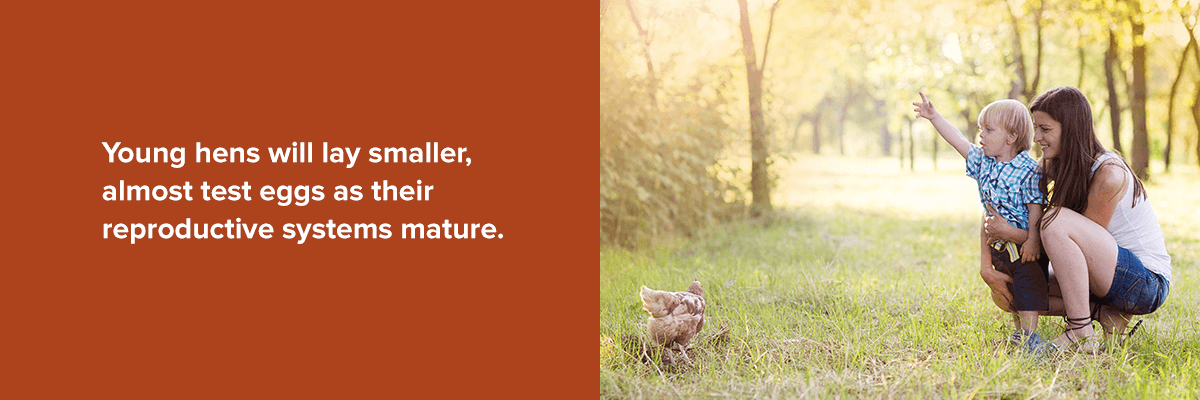
Similarly, older hens can begin laying large and unusual eggs as their reproductive system ages. Time and use can wear anyone down, and hens are no different. These larger or weird eggs are expected in older hens — the longer they’ve been laying, the more likely it is they’ll begin to experience some problems and deformities with their eggs.
Temperature
If birds are too cold or too hot, they might stop laying eggs entirely. Additionally, uncomfortable temperatures can lead to odd-looking eggs. When hens are unhappy, stressed, or irritated, their laying process is affected. Farmers must then keep chickens protected from falling winter temperatures and rising summer heat. Birds need cozy, comfortable conditions to lay regular eggs.
Light
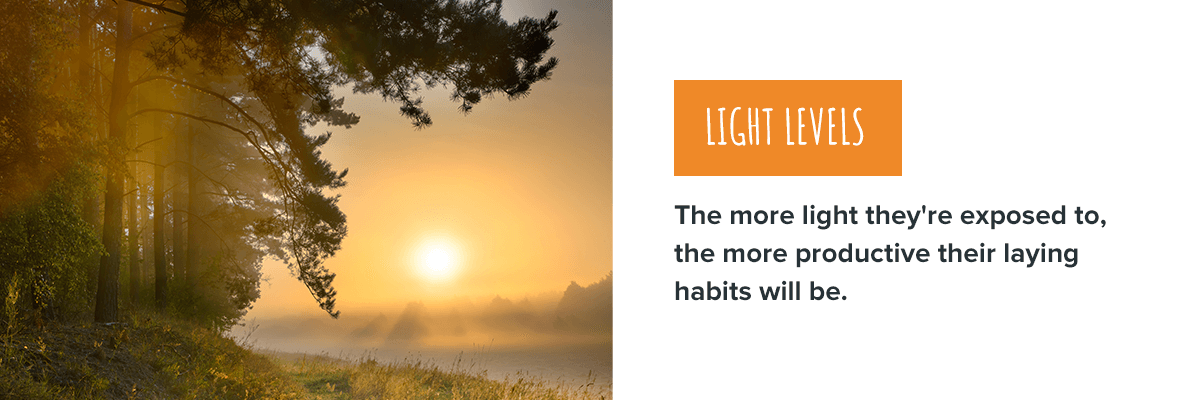
Light levels can affect laying habits. Chickens will stop laying eggs or will lay deformed eggs if they aren’t getting enough light during the day. Daylight helps to stimulate chicken’s egg layers’ reproductive cycle. The more light they’re exposed to, the more productive their laying habits will be. If it’s winter, farmers consider adding artificial light to ensure their chickens receive enough light during the day. This measure can help them stay de-stressed and will get their eggs back to normal.
Food
Getting normal, healthy eggs starts with what chickens eat every day. Chickens need to maintain their energy, calcium, and protein levels to produce eggs efficiently and quickly. Hens need high-quality, nutrient-dense food to ensure they get everything they need to make eggs without deformities. If someone feeds their chickens table scraps, scratch feeds, and whole grains, the birds’ diets will become inadequate, and they’ll produce deformed eggs.
Diet imbalances can even cause issues like oviductal prolapse in hens. This is when a hen’s reproductive tract expels along with an egg due to the egg being too large or the hen being too fat. Oviductal prolapse can result in permanent damage and even death for affected hens. Farmers can help their birds avoid egg deformities and health problems with nutritious feed. When chickens receive all their nutrition requirements, they can easily produce top-quality eggs.
Types of Irregular Eggs
Here are some possible egg irregularities and whether you can eat them:
Double Yolks
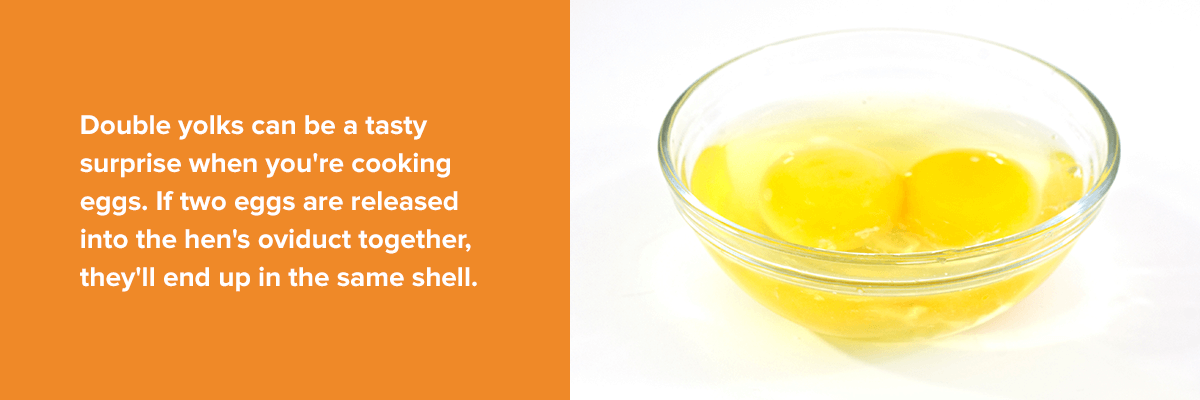
Double yolks can be a tasty surprise when you’re cooking eggs. If two eggs are released into the hen’s oviduct together, they’ll end up in the same shell. Double-yolk eggs are often larger than single-yolk eggs, which can make them more difficult for hens to pass.
We don’t know why some chickens produce double yolks, but they’re a delightful surprise. Some birds are genetically predisposed to lay double-yolk eggs and will even be bred to have them almost exclusively. Immature laying hens, called pullets, more commonly lay eggs with two yolks.
Double yolks are perfectly safe to eat and are great for omelets if you’re feeling hungry. You can even buy cartons of eggs that intentionally all have double yolks!
No Yolk
These weird eggs have some equally weird names — they’re also called wind eggs, cock eggs, fart eggs, and fairy eggs. Wind eggs can happen in mature hens but often occur in pullets. Pullets will usually lay wind eggs when their reproductive system is “warming up,” and they aren’t fully developed. A mature hen might lay a wind egg — if some reproductive tissue breaks away and stimulates egg-producing glands, you can end up with a no-yolk egg. The reproductive tissue gets treated like a yolk and becomes wrapped in albumen, membranes, and shell.
No-yolk eggs are edible and delicious.
No Shell
Eggs without shells can look pretty strange and alien. Since the shell is one of the last steps of the egg-laying process, it can get skipped over for several reasons. Pullets might lay no shell eggs as their first egg attempts, but no shell eggs can also occur from nutritional deficiencies like insufficient protein or calcium in the hen. Additionally, stress or phosphorous and vitamin D deficiency can lead to no shell eggs occurring.
Avoid eating no-shell eggs — the shell creates a protective barrier around the egg. Without this barrier, you have no way of knowing what bacteria and contamination are carried in the egg.
Thin Shells
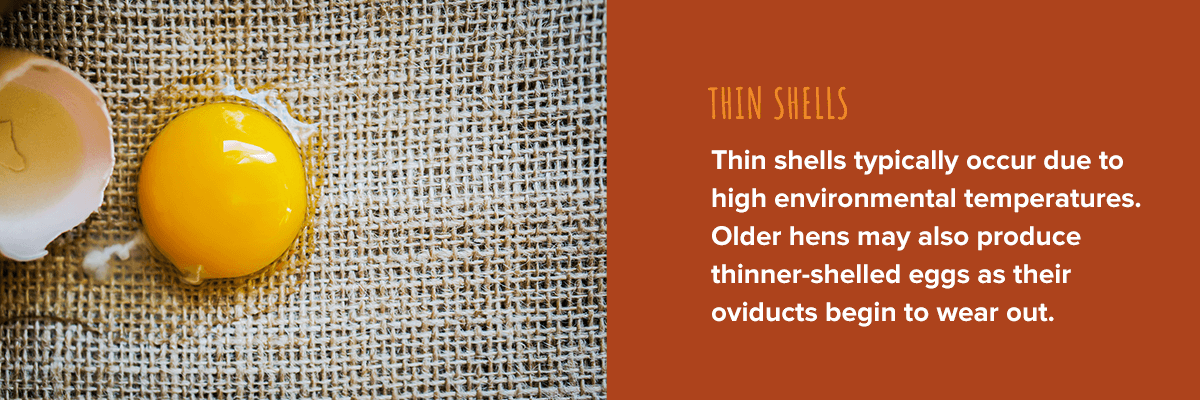
Thin shells typically occur due to high environmental temperatures. Older hens may also produce thinner-shelled eggs as their oviducts begin to wear out.
Thin-shelled eggs are safe to eat as long as the shell has not been punctured or cracked. You likely won’t find thin-shelled eggs in a carton you buy at the store, however, as they can’t be easily processed.
Sandpaper Shells
Eggs with rough or sandpaper shells might seem like odd eggs. They don’t occur often, but they can be more common in early lays. A double ovulation might produce one sandpaper egg and one no-shell egg. Additionally, excess vitamin D or calcium intake, disease, and defective shell glands can all lead to these eggs.
These eggs are also called pimpled eggs, and the size of their lumps of calcium can influence their grade. Smaller lumps can still earn an egg a Grade A quality, for instance. Like thin shells, sandpaper shell eggs are safe to eat if the shell remains completely intact.
Flat Eggs
A flat or slab-sided egg is caused by a second egg entering the shell gland before the first egg leaves. Since the second egg hasn’t completely calcified, the side that contacts the first egg becomes flattened and deformed. This process might occur due to changes in the chicken house lighting, disease, or stress. The flat side of the egg might have a thinner shell, so check for cracks or holes before eating.
Egg Within an Egg
An egg inside of an egg is called a counter-peristalsis contraction. These eggs are the result of an almost-ready egg reversing up the reproductive tract. Once it’s here, it might get another albumen layer and second shell, or it can meet up with a second egg, and the two become encased in one shell together. We don’t know why this happens, but it makes for an exciting breakfast surprise.
Overly Large Eggs
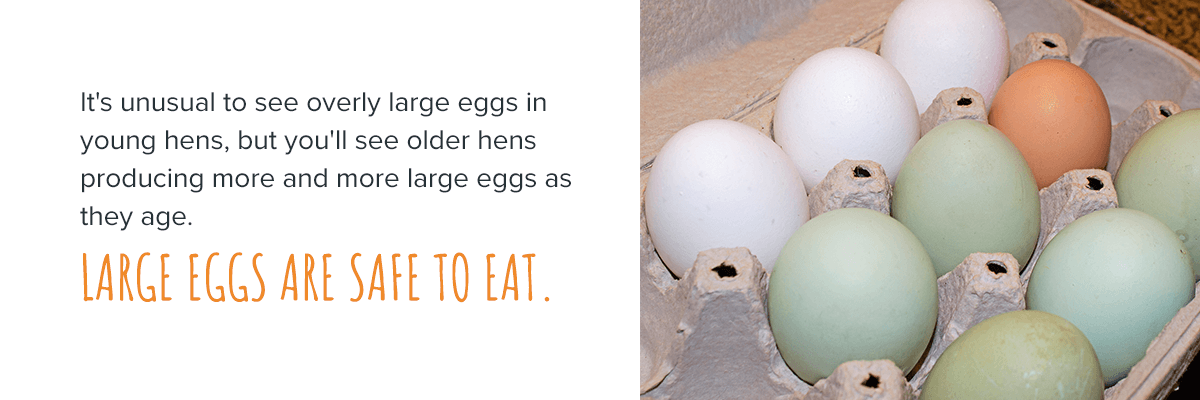
These eggs will often have a double yolk, although they might just be large, single-yolk eggs. The oviducts of older hens typically start to lose their elasticity, which can lead to larger eggs. It’s unusual to see overly large eggs in young hens, but you’ll see older hens producing more and more large eggs as they age. Large eggs are safe to eat, whether they have one yolk or two.
Overly Small Eggs
These eggs will usually come from pullets. Since their reproductive systems aren’t fully developed, they might lay a few smaller eggs before they start producing standard-sized eggs. Too-small eggs will usually have missing yolks. You can eat smaller eggs — you might even eat a couple in one sitting since they’re tiny!
Strange Coloration
Different eggshell colors can have different causes, like breed or diet. Eggs with unusual or missing pigmentation are totally safe to eat. Stress is the usual culprit — heat stress, in particular, can cause incomplete pigmentation. You might also see strange egg coloration due to viral infections or poor nutrition.
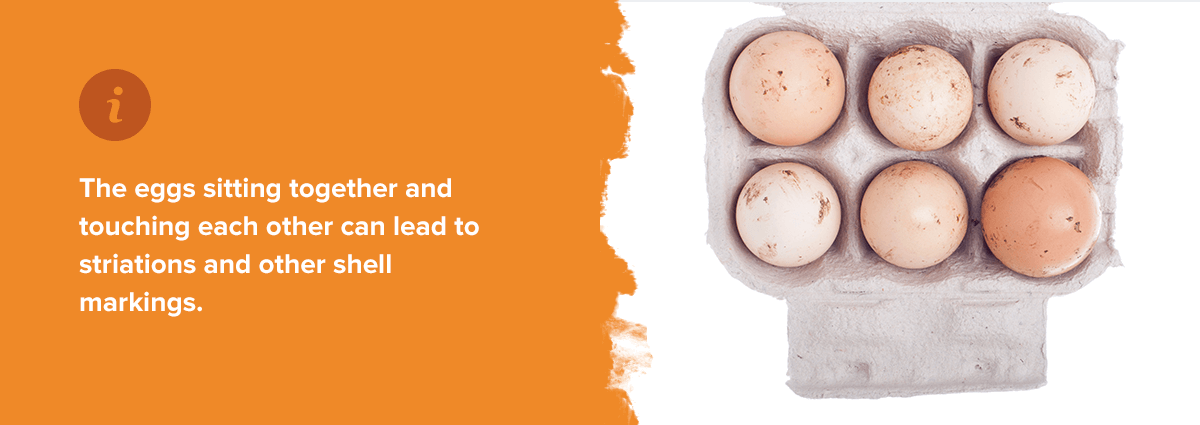
Another strange coloration you may see is striation. Coloring striations are caused by two eggs sitting in the shell gland pouch at the same time. The eggs sitting together and touching each other can lead to striations and other shell markings. If they notice unusual egg coloration, a farmer should check the chicken’s health to ensure the bird isn’t stressed or in need of medical attention.
Blood Spots
While blood spots might seem scary or off-putting, they won’t hurt you, and you can eat them without worry. These spots might be large clots that swim around in the albumen or tiny speckles in the yolk. Many people often think these are developing embryos, but this isn’t the case. Fertilized egg yolks have white spots, not blood, inside the yolk.
If you were to get eggs right from the hen, you might see the occasional egg with blood on the shell. These spots are the result of an overstretched vent, which is common among young hens. Simply wash off the shell and eat the egg as usual. When buying a carton of eggs in the store, you won’t usually see spots on the shell — companies often wash eggs with approved soaps to clean them before packaging. Blood spots are usually rare and aren’t anything to worry about.
Strange Texture
There are lots of potentially strange textures you could see in your eggs. Wrinkles, pimples, rough speckling, lumps, bumps, and more are all potential textures you’ll see.
One strange texture you might see is corrugated eggs. Corrugation happens during the plumping process — where membrane-covered eggs are pumped with nutrient-rich fluids before the shell is added. If plumping terminates before the whole process finishes, you get a corrugated egg. This error might be due to poor nutrition, heat stress, or other issues with birds.
These textures are usually due to issues in the shell gland, excess calcium, or some other internal factor. They usually aren’t an issue — as long as the shell isn’t broken — and won’t affect the taste of the egg.
Strange Shape
Like textures, shell shapes can come in wildly different configurations. Young hens often have immature shell glands, which can lead to odd shell shapes. This is usually nothing to worry about since the eggs will become normal once the hen reaches maturity.
For mature or older hens with fully-developed shell glands, strange shapes can occur from stress. Additionally, if a bird has infectious bronchitis, it might have resulted in a defective shell gland. You might find odd-looking eggs with tails or unusual oblong shapes, but this isn’t common.
Eggs with unusual shapes are typically safe to consume despite their strange appearance.
Speckled Eggs
Speckled eggs are beautiful-looking shells with small, freckle-like dots scattered across the shell. They’re much more common than many of the irregular eggs on this list and are safe and tasty. Speckles can be formed by a defective shell gland, excess calcium, or a disruption in the calcification process. These small speckles are simply extra calcium deposits — they look pretty, but there isn’t much more to them.
White Banded Eggs
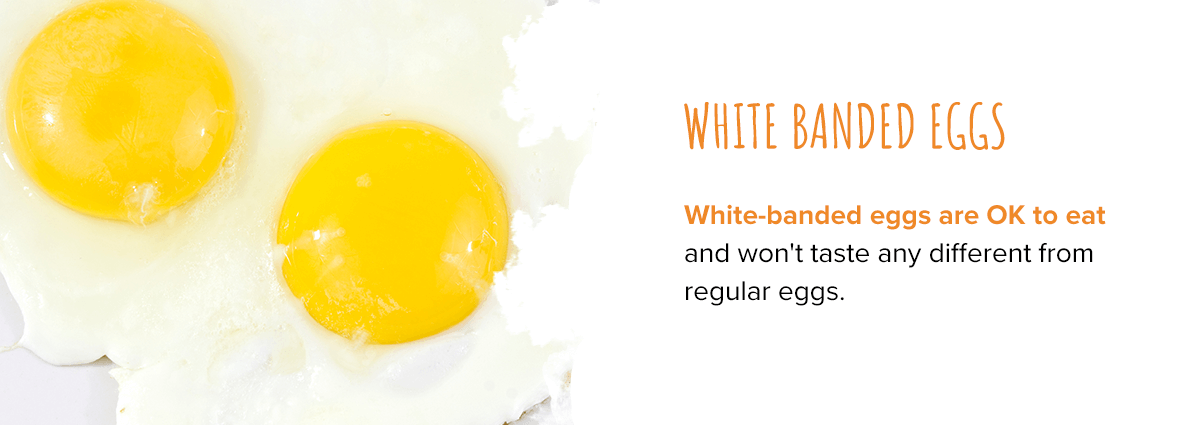
Eggs with bands around or on the egg are a common odd-looking egg. This look is the result of two eggs entering the oviduct together and making contact in the shell gland pouch. Since both eggs are contacting each other, it interferes with the calcification process. As the first shell of the egg is formed and interrupted by the second egg’s presence, the first egg gets an extra calcium layer — this causes the white band you see on the egg.
White-banded eggs are OK to eat and won’t taste any different from regular eggs.
Wrinkled Eggs
Shells with wrinkles or ridges — called “checks” — are known as “body-check” eggs. These eggs have become damaged by pressure or stress while in the shell gland. Cracks formed by pressure or stress are then repaired while the egg is in the shell gland, creating these wrinkles and ridges. While these wrinkles will make your eggs look odd, they should be fine to eat as long as the shells are intact.
Wrinkled eggs might be caused by stress in hens, mainly due to overcrowding. It might also be a sign the flock has infectious bronchitis, or the hen has a defective shell gland. Wrinkles can cause shells to become weakened, so inspect the surface for damage before consuming the egg.
Lash Eggs
Lash eggs aren’t eggs at all. They’re actually a mass of yellowish, waxy pus that only looks like an egg. Sometimes, they contain bits of albumen, yolk, egg membrane, blood, tissue from the oviduct wall, and eggshell. However, they’re mostly made of pus resulting from a salpingitis infection. This causes inflammation and infection in the hen’s oviduct, leading to irritation and the passing of lash eggs. By the time a hen passes a lash egg, she’s had the infection for a while and probably won’t recover.
Don’t ever eat a lash egg — they aren’t true eggs, and they’re made from nasty infection waste. You won’t find a lash egg in a carton you buy at the store. They look distinct from true eggs, and farmers and packagers would know to toss them.
Choose Sauder’s Eggs for High-Quality Eggs
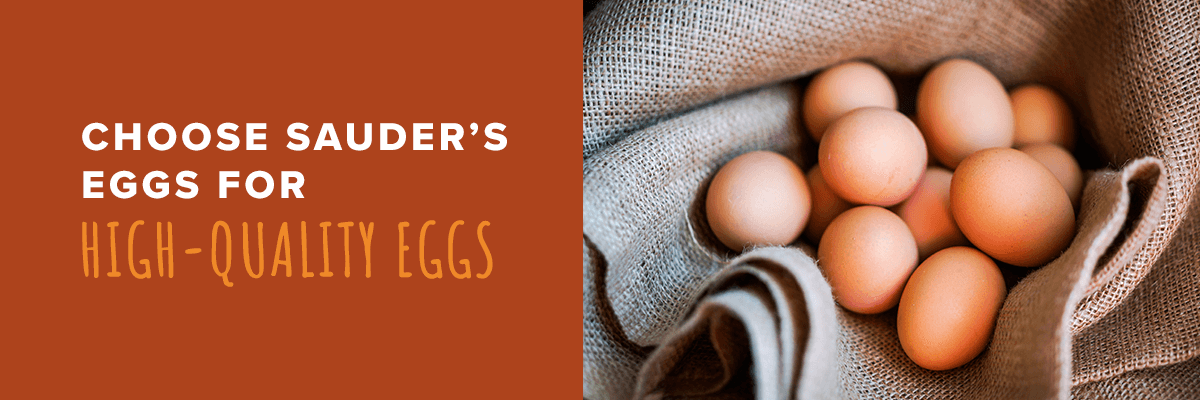
As a family-owned business, Sauder’s Eggs knows the importance of hands-on, quality care for chickens. While weird eggs aren’t 100% preventable, providing chickens with nutrition-packed feed and high standards of care helps ensure they remain healthy and happy all their lives. We work only with top farms that provide their birds with the best care so our customers can be sure they’re getting nutritious, top-notch eggs from our brand.
Sauder’s Eggs stands apart from other companies not only through our care standards but through our egg freshness. We work closely with family-owned farms to get you the freshest eggs possible. Our eggs typically arrive at the store the same day they were gathered — eggs are collected from their nests in the morning and taken to our facilities when they undergo processing using the latest and most effective technology. Once they’ve completed processing, they’re shipped right to our retailers and into your hands.
You can enjoy your Sauder eggs knowing that our birds are treated with the utmost respect, and our eggs are examined for deformities and issues. Trust us to provide your table with premium-quality eggs for all your different egg needs.
Interested in finding a Sauder’s Eggs retailer near you? Use our store locator and get your hands on quality farm-fresh eggs.
